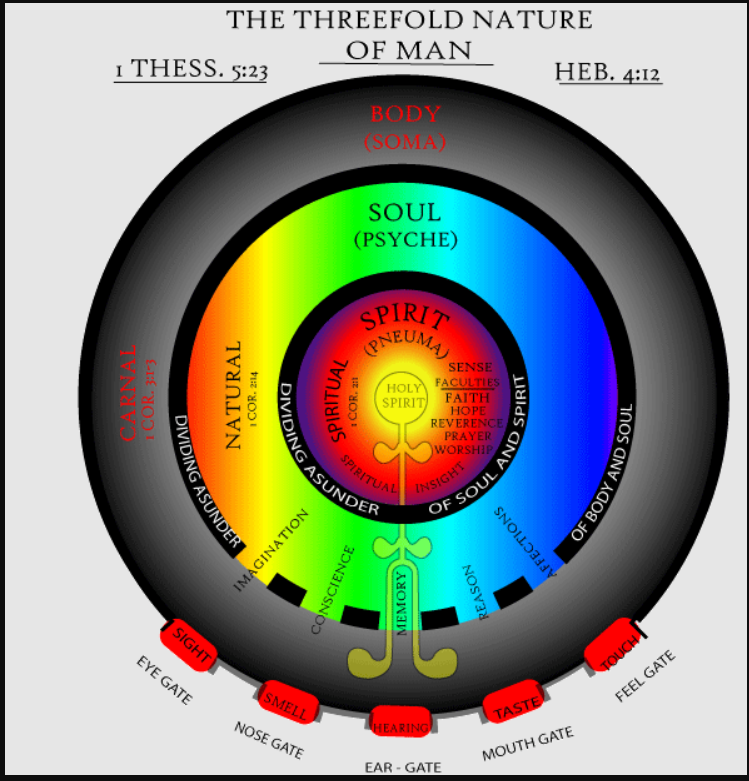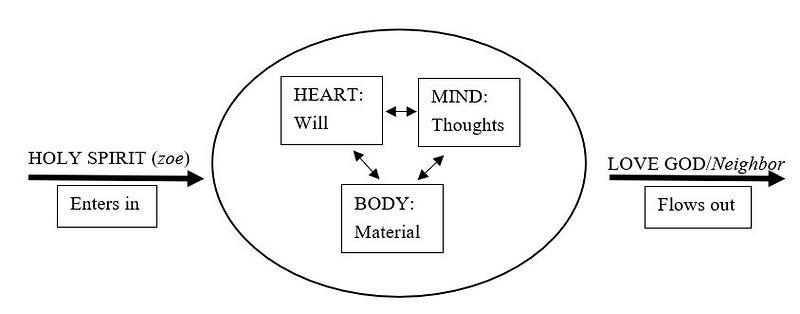Living from the Inside Out
Body, soul, and spirit

Images of the body, soul, and spirit abound throughout cultures and among people. Some are clearer than others. Most recognize these interact to form human beings. Examine the image.
“Now may the God of peace himself sanctify you completely, and may your whole spirit and soul and body be kept blameless at the coming of our Lord Jesus Christ.” 1 Thessalonians 5:23
Scofield details the differences
On page 1270 of the Scofield Reference edition of the King James Bible that I studied as a teenager, an extended explanation is written. I had spent $20 on a Bible, money from a graduation gift, 58 years ago, for this Bible. Today I read that explanation under 1 Thessalonians 5:23 for the first time. Then I found this image from the web. Others are obviously interested in the passage and illustrate the words. Both help me to understand more about the body, soul, and spirit.
O.T = Old Testament written primarily in Hebrew
N.T = New Testament written in Greek
Man a trinity. That the human soul and spirit are not identical is proved by the facts that they are divisible. Hebrews 4:12 and that soul and spirit are sharply distinguished in the burial and resurrection of the body. It is sown a natural body (soma psuchikon= “soul- body”), it is raised a spiritual body (soma pneumatikon). 1 Corinthians 15:44. To assert, therefore, that there is no difference between soul and spirit is to assert that there is no difference between the mortal body and the resurrection body. In Scripture use, the distinction between spirit and soul may be traced. Briefly, that distinction is that the spirit is that part of man which “knows” 1 Corinthians 2:11 his mind; the soul is the seat of the affections, desires, and so of the emotions, and of the active will, the self. “My soul is exceeding sorrowful” Matthew 26:38 see also ; Matthew 11:29; John 12:27. The word transliterated “soul” in the O.T. (nephesh) is the exact equivalent of the N.T. word for soul ( (Greek — εὐψυχέω ), and the use of “soul” in the O.T. is identical with the use of that word in the N.T. (see, e.g.) ; Deuteronomy 6:5; Deuteronomy 14:26; 1 Samuel 18:1; 1 Samuel 20:4; 1 Samuel 20:17; Job 7:11; Job 7:15; Job 14:22; Psalms 42:6; Psalms 84:2. The N.T. word for spirit (pneuma) like the O.T. (ruach), is trans. “air”, “breath”, “wind,” but predominantly “spirit,” whether of God (e.g.) ; Genesis 1:2; Matthew 3:16 or of man ; Genesis 41:8; 1 Corinthians 5:5. Because man is “spirit” he is capable of God-consciousness, and of communication with God ; Job 32:8; Psalms 18:28; Proverbs 20:27 because he is “soul” he has self- consciousness ; Psalms 13:2; Psalms 42:5; Psalms 42:6; Psalms 42:11 because he is “body” he has, through his senses, world consciousness.
Google images of body, soul, and spirit
Not all images of the body, soul, and spirit align with the Biblical viewpoint. However, most aknowledge that the soul is what lasts after the body decomposes into dust, and the breath is gone. ABC is the air, breath, circulation that EMTs check for when on an emergency call. Can they get air? Are they breathing? What about circulation of blood? Life requires spirit for the body to remain.
Basic aspects of a human life
Dallas Willard in Renovation of the Heart identifies six basic aspects of human life. These align with the image of the body, soul, and spirit.
1. Thought (images, concepts, judgments, inferences)
2. Feeling (sensation, emotion)
3. Choice (will, decision, character)
4. Body (action, interaction with the physical world)
5. Social context (personal and structural relations to others)
6. Soul (the factor that integrates all of the above to form one life)
“Spiritual formation in Christ is the process leading to that ideal end, and its result is love of God with all of the heart, soul, mind, and strength, and of the neighbor as oneself. The human self is then fully integrated under God. Spiritual formation for the Christian basically refers to the Spirit-driven process of forming the inner world of the human self in such a way that it becomes like the inner being of Christ himself…the outer life of the individual becomes a natural expression or outflow of the character and teachings of Jesus.”
The Holy Spirit (Spirit-driven) interacts with the natural human spirit to transform a Christ-follower into the image of Christ. In other words, we are being conformed into the image of Jesus. That is the meaning of being a disciple.
Richer meaning
At the point of salvation, God gives us a new heart. He does not give us a new mind. We are to renew our mind by replacing thoughts with His word. Do not leave it empty. Put OFF the Old. Put ON the New.
What is the biblical meaning of soul?
The only Hebrew word traditionally translated “soul” (nephesh) in English-language Bibles refers to a living, breathing conscious body, rather than to an immortal soul. In the Greek Septuagent psyche is used to translate each instance of nephesh.
Tim Mackie explains further.

For thousands of years every morning and evening, Jewish people have prayed these well-known words as a way of expressing their devotion to God. They’re called the Shema. Hear O Israel, the LORD is our God the LORD is one, and as for you, you shall love the LORD your God with all of your heart, with all of your soul, and with all of your strength. We’re going to look at the word soul. The Hebrew word is nephesh. It occurs over 700 times in the Old Testament.
The common English translation of this word is soul, and that’s kind of unfortunate. Here’s why. The English word soul comes with lots of baggage from ancient Greek philosophy. It’s the idea that the soul is a non-physical, immortal essence of a person that’s contained or trapped in their body to be released at death. It’s a “ghost in the machine” kind of idea. This notion is totally foreign to the Bible. It’s not at all what nephesh means in biblical Hebrew.
So even though nephesh is often translated as soul, the Hebrew word really refers to the whole human as a living, physical organism. In fact, this is why biblical people can often use this word to refer to themselves. And it gets translated “me” or “I.” Like in Psalm 119, most translations read, “Let me live, that I may praise you.” In Hebrew, the poet literally says, “Let my nephesh live, that it may praise you.” By using nephesh, the poet emphasizes that their entire being, their life and their body, offer thanks to God.
From the inside out
Human life depends on air, breathing in and out. Spiritual life depends on the Holy Spirit working in and through us to become who God created us to be. This soul surrounding the heart, mind, and body lives forever. For Christians after the death of the human physical body, a resurrection body like Jesus Christ is provided within the eternal soul. The Spirit of God is the life-giving energy of inspiration now and forever as a free gift to be accepted. Rejecting the call of the Holy Spirit is the sin that cannot be forgiven because He is not received.

“The Scripture tells us that all human beings are souls, and as soulful beings, each of us is being formed spiritually. The state of the soul, however, depends on whether we are in rebellion against God or have been penetrated by the life of God, whether we are moving away from God or toward God” (Ogden, The Essential Commandment).
Soul surround may be a better illustration. The spirit inspires our breath, with life-giving air to energize the soul that houses the body, mind, and heart of who we are. Thinking deeply on these terms and application to life gives purpose and meaning to being alive. Really alive! These images help to convey the immaterial soul.

